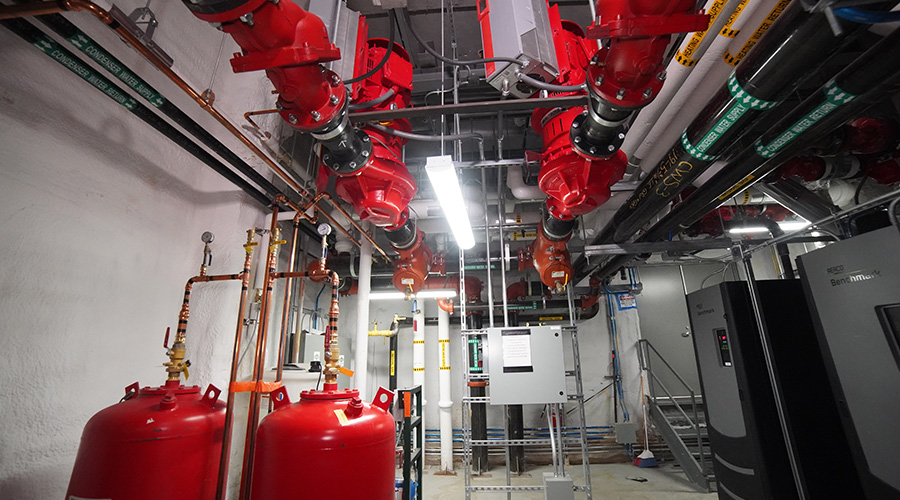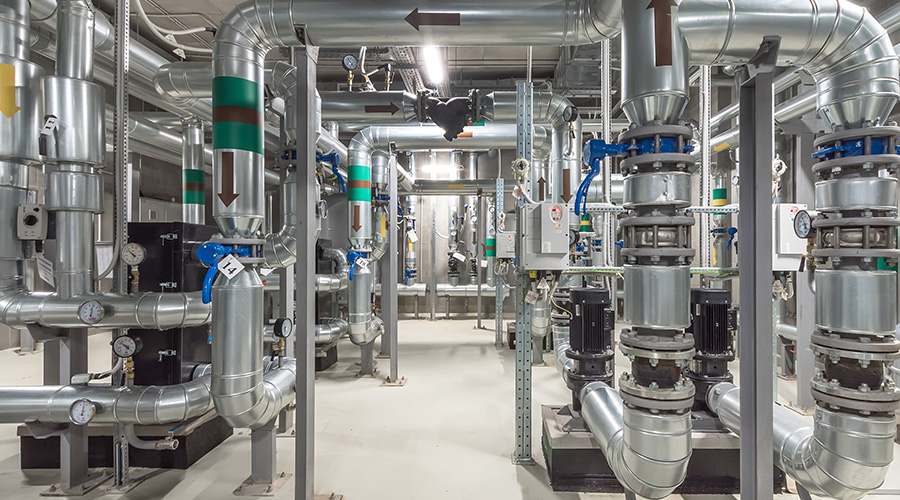Avoiding the HVAC Hot Seat
Facility executives who ignore warning signs of HVAC problems may find themselves with a lot of explaining to do if the system fails
What’s wrong with the system, HAL?” asked the astronaut in the film classic, 2001: A Space Odyssey. “I don’t know, Dave,” answered the computer. “But if we put it into operation and let it fail, the cause of the problem should then become obvious.”
Such is the way that many HVAC systems are treated: Let it run until it fails, and then try to figure out the problem. But when business, sales or employee time is lost, the cost is typically many times greater than the small expenses involved in proper maintenance. One facility executive drew this analogy: “If you hear a knocking sound in your car’s engine, do you wait for the engine to fail before having it examined by a qualified mechanic?”
HVAC complaints, mold, odors or high energy bills could be that knocking in the engine that needs attention before a system fails, creating greater inconvenience and higher cost than if earlier attention had been given to the problem.
One difficulty is that problems are not always obvious in their early stages. While water pouring out of a ceiling or an angry call from a sweating executive may draw immediate attention, not all problems occur so suddenly. Mold development, for example, may take an entire season to appear while increased absenteeism due to illness may not become obvious until an end-of-the-year productivity assessment. Some problems exist for years, but only become visible when triggered by an unusual condition, such as a cool but very humid summer.
During discussions with facility executives about ways to stay on top of potential HVAC problems, several requirements stood out:
- Procedures and systems must be in place to detect problems.
- Operating and maintenance personnel must be able to interpret symptoms.
- HVAC systems, diagnostics and follow-ups must be well documented to avoid repeating problems.
In many cases, problems that could have been detected before they became costly instead continued, resulting in major damage. Had a few sensors been in place, or a space been “walked” while unoccupied, or maintenance steps been well documented, a small leak caused by a freeze-up could have been avoided before it turned into a small flood.
A Few Horror Stories
Tales told by facility executives illustrate problems and steps that could have been taken to avoid them.
While a college was on winter break and parts of the facility, including its cafeteria, were unoccupied, a control valve feeding a heating coil in a rooftop air handling unit failed during a sustained cold snap. The lack of water flow caused the heating coil to freeze and split. The cafeteria was empty, and no low-temperature alarms existed. Baseboard radiation was sufficient to maintain the internal room temperature so none of the cafeteria piping froze, but when the damaged coil thawed, water poured from it into the ducts serving the cafeteria. Because the problem was not found for several days, damage occurred to the space and ductwork.
The root cause of the problem was traced to poor installation or maintenance: The rooftop unit’s coils were insufficiently weatherized to avoid a freeze condition. Although the valve failure was the immediate cause of the problem, the same problem could have resulted from simply shutting down the system for an extended period during the winter.
Had a facility worker been walking the space daily during the winter break, water dripping from the ductwork and diffusers would likely have been seen less than 24 hours after it started. While not an ideal way to minimize damage, ongoing examination is a low-tech way to spot problems before they become unmanageable.
A better way to avoid such a situation would be temperature sensors feeding the building management system and software that issues alarms when out-of-spec room temperatures are detected. The failure of the heating coil caused the discharge temperature into the room to be far below specification, but no alarm was programmed to highlight that fact to the system operator.
Other control and system changes could also be employed to avoid such problems. Pursuing thorough documentation during commissioning should have revealed the lack of weatherization (i.e., injection of antifreeze) into the circulating water flowing through the hot water coil.
In another case, mold developed in a library because of insufficient humidity control during an unusually cool and moist summer. A mechanic had previously noticed a slightly musty odor but ignored it as simply the smell of old books. Several problems contributed to the condition:
- The relatively cool temperatures allowed many hours of an economizer cycle (operating only on dry-bulb temperatures, so humidity was not being sensed) bringing in 100 percent outside air with little or no mechanical cooling that would have dried out the air through condensation of humidity on the cooling coil.
- Some parts of the library lacked sufficient air circulation, allowing moisture to build up on densely packed microfiche files to the point where mold spores, which are always present in air and in dust, found a comfortable breeding ground.
The lack of tight humidity control of a library space, where rare books are often stored, was considered a design error that should have been caught prior to installation, but the presence of a new odor should have caused some investigation. The issue had not previously arisen because unusual weather conditions had not yet challenged the system.
Documentation
In a third case, occupants had complained several times of a lack of cooling during very hot spells, but the problem re-occurred despite actions taken by several different controls mechanics. To respond to the complaints, the variable speed fan (VAV) control system had been shut off, resulting in full fan speed at all times. The systems operator had set the outside air damper to minimum flow year-round, and various other efforts had been made during several past summers. The result was higher energy costs while occupants continued to complain.
When the system was reviewed as part of an overall building recommissioning, it was found that some of the control panel wiring had been overridden inside control panels. No record had been made of this change so the condition was never corrected. Instead, simpler efforts that overrode other systems (e.g., VAV, economizer cycle) were implemented that merely created a new problem: higher energy bills.
Lack of documentation of the prior alterations was endemic at the facility; major improvements were made to work order tracking and logging.
Lessons Learned
As Ben Franklin said, “A little neglect may breed great mischief.” Small problems may escalate into big ones that cost a company its operating budget — or a facility executive his job. Some who would now do things differently offered the following advice.
- Start at the design stage: Don’t build problems into systems or create complexities that are difficult to understand, control or maintain.
- Commission everything and keep good records. Recommission every 2 to 3 years.
- Document all changes, repairs and upgrades in a form that may be easily found and accessed by those responsible for maintaining systems. Some now do so via a computer database accessible through wireless PDAs.
- Don’t defer basic maintenance. Fixing HVAC failures is invariably more expensive than regular maintenance.
- Know your systems and how they should be operating. Guessing about sequences of operation and operating schedules will only result in chasing “ghosts” instead of resolving problems.
- Avoid installing anything much “smarter” than the people designated to operate and maintain it. Whizbang technologies may be tantalizing, but are often the first to be bypassed to immediately resolve a complaint. If existing systems challenge maintenance personnel, improve training or simplify system operation.
- Keep an orderly plan room and library of equipment manuals/specs so troubleshooting doesn’t start out as a chaotic search for such documents.
- Benchmark energy use when systems are operating normally. Rising energy use may provide facility executives a signal of possible problems with the HVAC system
- Encourage technicians and building personnel to report any unusual room conditions rather than ignoring them until an obvious problem exists.
- Inspect spaces routinely to develop an eye and nose for odd conditions. One savvy facility executive at an institution watches for open windows during very cold or very warm periods, which usually indicate overheating or overcooling, as occupants use windows to control temperature.
- Read the manual. If a manufacturer suggests a particular type of lubricant be used, don’t use something else simply because it’s more convenient — or cheaper — to do so.
- During troubleshooting of a problem, consider all possible causes of failure and not just those found in the past or common to operator experience. One good, and free, tool for analyzing and solving indoor air quality issues is EPA’s I-BEAM diagnostic and training software tool.
- When a building management system or HVAC system upgrade is being pursued for other reasons, build in remote diagnostic and correction capabilities. Doing so may also help minimize the use of field personnel having widely varying levels of knowledge and expertise.
- Give credence to all complaints, regardless of the source. While some complaints seem to go away on their own, that does not mean the underlying problem has ceased to exist. Inattention may instead result in occupants taking HVAC into their own hands and creating new problems by blocking off a diffuser or, as occurred in one overcooled office, plugging in electric heaters that then caused circuit breakers to pop, shutting down office computers – and halting the tenant’s business.
Lindsay Audin is president of EnergyWiz, an energy consulting firm based in Croton, N.Y. He is a contributing editor for Building Operating Management.
DDC: Often A Savior, But Sometimes A Saboteur
In a category by itself — as both a source of problems and source of solutions — are the direct digital controls (DDC) that, at many facilities, have replaced pneumatic systems for actuating dampers, valves and other equipment. In many cases, DDC technology has challenged mechanics and even the engineers specifying it, resulting in problems much more technically sophisticated than the people directed to solve them.
An excellent review of the problems related to improper DDC implementation and ways to address them has been assembled by Gregory Churchill of the Oregon Department of Energy. Many Oregon schools with new DDC systems did not realize the expected energy savings often claimed by DDC vendors, and some were experiencing serious operating problems. The 12-page study provides many insights on dealing successfully with this technology.
|
Related Topics:











